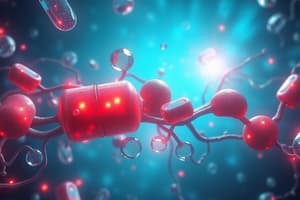Podcast
Questions and Answers
What is the primary concern when using mu agonists in pain management?
What is the primary concern when using mu agonists in pain management?
- They may result in increased sedation without analgesia.
- They can lead to respiratory depression. (correct)
- They provide excellent pain control in all species.
- They can cause hypertension.
Which opioid antagonist is most commonly used for reversing the effects of opioids?
Which opioid antagonist is most commonly used for reversing the effects of opioids?
- Buprenorphine
- Naloxone (correct)
- Butorphanol
- Fentanyl
What is the recommended starting approach for titrating Naloxone?
What is the recommended starting approach for titrating Naloxone?
- Only give Naloxone if the patient is in severe pain.
- Dilute to 50mL and give 1mL every 10 minutes.
- Draw up 0.04mg/kg and administer 10% at intervals until alert. (correct)
- Administer a full dose immediately.
What is a significant disadvantage of using analgesics in dogs compared to cats?
What is a significant disadvantage of using analgesics in dogs compared to cats?
Which combination of medications should be avoided to prevent serotonin syndrome?
Which combination of medications should be avoided to prevent serotonin syndrome?
What is a significant characteristic of opioids in relation to pain management?
What is a significant characteristic of opioids in relation to pain management?
Which opioid receptor is primarily associated with pain modulation?
Which opioid receptor is primarily associated with pain modulation?
What effect do opioids predominantly have on neurotransmitter release?
What effect do opioids predominantly have on neurotransmitter release?
What is a key side effect associated with the use of opioid drugs?
What is a key side effect associated with the use of opioid drugs?
Which of the following statements is true regarding hydromorphone?
Which of the following statements is true regarding hydromorphone?
What condition can excessive use of morphine potentially lead to?
What condition can excessive use of morphine potentially lead to?
How do mixed opioids differ from full agonists?
How do mixed opioids differ from full agonists?
Which of the following is NOT a common side effect of opioid usage?
Which of the following is NOT a common side effect of opioid usage?
What is a characteristic of opioid full agonists?
What is a characteristic of opioid full agonists?
What is the common use of opioids in relation to gastrointestinal function?
What is the common use of opioids in relation to gastrointestinal function?
What is the primary function of CNS drugs?
What is the primary function of CNS drugs?
Which type of CNS drug binds to a receptor and produces a maximum response?
Which type of CNS drug binds to a receptor and produces a maximum response?
What is the role of nociceptors in the pain pathway?
What is the role of nociceptors in the pain pathway?
Which of the following best describes a partial antagonist?
Which of the following best describes a partial antagonist?
During which phase of the pain pathway does sensory electric stimulus convert into a pain signal?
During which phase of the pain pathway does sensory electric stimulus convert into a pain signal?
What defines a competitive antagonist in the context of drug activity?
What defines a competitive antagonist in the context of drug activity?
Which statement about partial agonists is true?
Which statement about partial agonists is true?
What impact do endogenous opioid endorphins have on the pain pathway?
What impact do endogenous opioid endorphins have on the pain pathway?
What is a key advantage of Fentanyl in comparison to other opioids?
What is a key advantage of Fentanyl in comparison to other opioids?
What is a disadvantage of using Fentanyl?
What is a disadvantage of using Fentanyl?
What is the primary mechanism of action for Butorphanol?
What is the primary mechanism of action for Butorphanol?
How long does it take for a Fentanyl transdermal patch to reach full effectiveness?
How long does it take for a Fentanyl transdermal patch to reach full effectiveness?
What is the primary reason for caution when using Fentanyl patches?
What is the primary reason for caution when using Fentanyl patches?
Which opioid is considered to have weaker analgesic properties compared to morphine?
Which opioid is considered to have weaker analgesic properties compared to morphine?
Which aspect of Fentanyl's administration contributes to its lower likelihood of causing vomiting?
Which aspect of Fentanyl's administration contributes to its lower likelihood of causing vomiting?
What is a primary effect of administering high doses of Fentanyl?
What is a primary effect of administering high doses of Fentanyl?
What is the method of delivery that allows for continuous analgesia when using Fentanyl?
What is the method of delivery that allows for continuous analgesia when using Fentanyl?
Which factor is NOT a consideration when applying a Fentanyl patch?
Which factor is NOT a consideration when applying a Fentanyl patch?
What is a significant advantage of using partial agonists like buprenorphine in compromised patients?
What is a significant advantage of using partial agonists like buprenorphine in compromised patients?
Which of the following is a disadvantage of methadone?
Which of the following is a disadvantage of methadone?
What primarily limits the effectiveness of the analgesic effect of buprenorphine at high doses?
What primarily limits the effectiveness of the analgesic effect of buprenorphine at high doses?
Which property of tramadol contributes to its ability to reduce pain perception?
Which property of tramadol contributes to its ability to reduce pain perception?
Why should buprenorphine not be given with pure Mu agonists?
Why should buprenorphine not be given with pure Mu agonists?
What effect does buprenorphine have on sedation in dogs compared to cats?
What effect does buprenorphine have on sedation in dogs compared to cats?
Which of the following describes the primary mechanism of action of methadone?
Which of the following describes the primary mechanism of action of methadone?
What duration of analgesia is typically expected for buprenorphine in cats?
What duration of analgesia is typically expected for buprenorphine in cats?
What is a noted pharmacological disadvantage of tramadol?
What is a noted pharmacological disadvantage of tramadol?
What primary clinical circumstance makes the use of partial agonist analgesics favorable?
What primary clinical circumstance makes the use of partial agonist analgesics favorable?
Flashcards
CNS Drugs
CNS Drugs
Drugs that influence the nervous system, affecting communication between the spinal cord and brain.
Agonist
Agonist
A drug that binds to a receptor and initiates a response, providing a full effect.
Antagonist
Antagonist
A drug that binds to a receptor but does not trigger a response, preventing other drugs from binding.
Mixed Agonist Antagonist
Mixed Agonist Antagonist
Signup and view all the flashcards
Transduction
Transduction
Signup and view all the flashcards
Transmission
Transmission
Signup and view all the flashcards
Modulation
Modulation
Signup and view all the flashcards
Perception
Perception
Signup and view all the flashcards
Analgesic Drugs
Analgesic Drugs
Signup and view all the flashcards
Opioids
Opioids
Signup and view all the flashcards
Narcosis
Narcosis
Signup and view all the flashcards
Mu Receptor
Mu Receptor
Signup and view all the flashcards
Kappa Receptor
Kappa Receptor
Signup and view all the flashcards
Opioid Mechanism of Action
Opioid Mechanism of Action
Signup and view all the flashcards
Respiratory Depression
Respiratory Depression
Signup and view all the flashcards
Morphine
Morphine
Signup and view all the flashcards
Hydromorphone
Hydromorphone
Signup and view all the flashcards
Ileus
Ileus
Signup and view all the flashcards
Fentanyl (Duragesic, Fentadon)
Fentanyl (Duragesic, Fentadon)
Signup and view all the flashcards
Fentanyl Advantages
Fentanyl Advantages
Signup and view all the flashcards
Fentanyl Disadvantages
Fentanyl Disadvantages
Signup and view all the flashcards
Fentanyl Administration
Fentanyl Administration
Signup and view all the flashcards
Meperidine (Demerol)
Meperidine (Demerol)
Signup and view all the flashcards
Butorphanol (Torbugesic)
Butorphanol (Torbugesic)
Signup and view all the flashcards
Longer Duration of Action
Longer Duration of Action
Signup and view all the flashcards
Fentanyl Transdermal Patches
Fentanyl Transdermal Patches
Signup and view all the flashcards
Fentanyl Patch Application
Fentanyl Patch Application
Signup and view all the flashcards
Fentanyl Patch Placement
Fentanyl Patch Placement
Signup and view all the flashcards
Alpha 2 Agonists
Alpha 2 Agonists
Signup and view all the flashcards
Opioid-Induced Respiratory Depression
Opioid-Induced Respiratory Depression
Signup and view all the flashcards
Naloxone (Narcan) Action
Naloxone (Narcan) Action
Signup and view all the flashcards
Alternatives to Full Opioids
Alternatives to Full Opioids
Signup and view all the flashcards
Titration of Naloxone
Titration of Naloxone
Signup and view all the flashcards
Partial Agonist
Partial Agonist
Signup and view all the flashcards
Full Agonist
Full Agonist
Signup and view all the flashcards
Buprenorphine
Buprenorphine
Signup and view all the flashcards
Partial Opioid Agonist
Partial Opioid Agonist
Signup and view all the flashcards
Methadone
Methadone
Signup and view all the flashcards
Mixed Mu/Kappa Agonist
Mixed Mu/Kappa Agonist
Signup and view all the flashcards
Tramadol
Tramadol
Signup and view all the flashcards
Sedative Opioid
Sedative Opioid
Signup and view all the flashcards
Analgesia Plateau
Analgesia Plateau
Signup and view all the flashcards
Study Notes
Nervous System Drugs: Analgesics
- CNS drugs alter nerve impulse transmission between the spinal cord and brain. These drugs can be stimulatory or depressive.
- Agonists have good receptor affinity and produce maximum response. They attach to the receptor to trigger a response.
- Antagonists have good receptor affinity but block response, lacking intrinsic activity, inhibiting the drug's response. They attach to the receptor, preventing the agonist from binding.
- Mixed agonist-antagonists can bind to and activate opioid receptors while also blocking other opioid effects.
- Partial agonists exert only a partial effect, while partial antagonists replace stronger drugs, producing reduced effects at the receptor. The resulting effect is similar to the stronger drug but weaker.
- Competitive antagonists block the actions of other drugs by attaching to the same receptors, preventing the other drug from binding.
Pain Pathway
- Transduction: Painful stimuli (chemical, thermal, mechanical) are converted into electrical signals.
- Transmission: Electrical signals travel from peripheral nerves to the spinal cord and CNS.
- Modulation: The CNS dampens pain signals using the sympathetic nervous system.
- Perception: Conscious awareness of pain. Nociceptors, (free nerve endings) transmit signals to the spinal cord, then to the thalamus, reticular formation, limbic system and the cerebral cortex, ultimately resulting in the perception of the pain.
- Pain signals travel through peripheral nerves to the dorsal horn of the spinal cord, and then to the brain. This includes the thalamus, reticular formation, limbic system, and the cerebral cortex.
Analgesic Drugs (Opioids)
- Act on all parts of the pain pathway. Highly controlled due to their addictive potential.
- Used in pain management, especially during surgery and to minimize the amount of anesthetic needed.
- Used initially to treat diarrhea. Reduce ileus (prevent constipation). Used for suppressing coughs.
- Opioids have Mu and Kappa receptors, found throughout the pain pathway.
- They decrease the release of excitatory neurotransmitters, influencing postsynaptic sites.
- These receptors have sub-receptors; not all animal species react to opioids in the same way.
Effects of Opioids
- Respiratory depression (decreased respiratory rate and volume, leading to increased carbon dioxide levels and decreased oxygen levels).
- Possible respiratory and cardiac arrest in overdose cases.
- Sedation.
- Nausea, vomiting, hypersalivation.
- Reduced gastrointestinal secretions, and decreased movement.
- Euphoria (positive effects) or dysphoria (negative effects).
- Pupil constriction or dilation.
- Slowing of the heart rate (Bradycardia).
- Histamine release (hives, redness; mostly with Morphine).
Opioid Receptors
- Mu (pain): Primary target for analgesics, causes reduced GI motility.
- Kappa (sedation): Causes sedation, analgesia, and reduced respiratory depression compared to Mu agonists.
Analgesic Drug Classifications
- Full agonists produce maximal response.
- Partial agonists produce less effective responses than full agonists.
- Full antagonists block agonist effects and prevent binding.
Opioid Antagonists (Reversal)
- Naloxone (Narcan): works by competing with opioid receptors, reversing their effects.
- Used for opioid overdoses to reverse respiratory depression, sedation, and other negative effects. Start low and titrate upwards as needed in overdose cases. Bolus dosages are often used in emergencies.
Studying That Suits You
Use AI to generate personalized quizzes and flashcards to suit your learning preferences.




